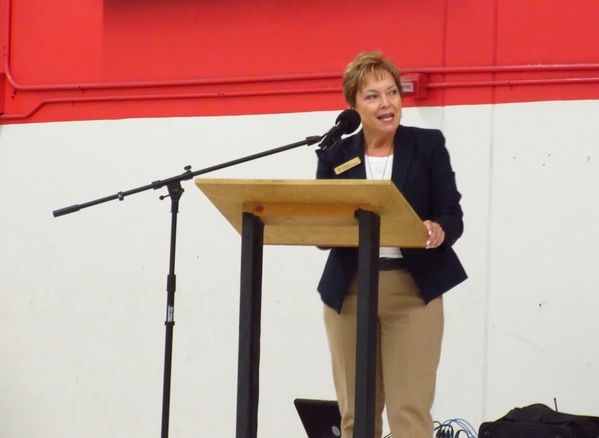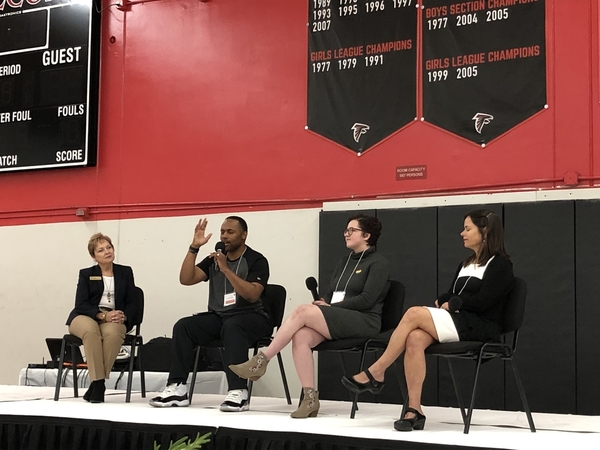Elizabeth Huntley recalls the day when her family’s life was turned upside down. “One day my mom woke up and she packed up all of our clothes, all five of us…and she took me and my younger sister who had the same father… down to my paternal grandmother’s house…and she left us there. She took my middle sister to a town near Birmingham, Ala., and left her there. She took my only brother and an older sister back to Huntsville and left them at a sister’s house. Then she went back to that housing project, she went up to her room. She took out a gun and she committed suicide,” said Huntley, an Alabama-based attorney and a child advocate.

There was silence in the Fairfield High School gymnasium in Fairfield, Calif., where more than 170 people had gathered on May 18 for an unusual summit organized by Solano Kids Thrive. Spearheaded by First 5 Solano, the organization includes a wide cross-sector of county residents. It includes parent advocates, non-profit organizations, the superintendent of schools, social service and child service agencies, a member of the board of supervisors, physicians and public health providers, and youth organizations. Their common purpose has centered on raising awareness about childhood trauma, and how just one caring adult in the life of a child experiencing trauma can make a difference. And now they were moving into the next step: taking action.
Their goal was rooted in research that emerged from the landmark Centers for Disease Control and Prevention/Kaiser Permanente Adverse Childhood Experiences (ACEs) Study that found stark and substantial links between 10 different types of common childhood traumas such as divorce, living with parent who’s dependent on alcohol or is depressed, divorce, or experiencing verbal abuse and the adult onset of chronic disease, mental illness, violence and being a victim of violence. Now with this summit they were launching a wager: In taking the next step of asking members of the community to be a part of this, would it make a difference in Solano County residents’ lives? What would the community contribute?
For Huntley, the notion of a caring adult in her life was pivotal, but it didn’t come right away. Nobody had told her what had happened to her mother, who had become addicted to heroin, and her father, who had been in and out of jail for dealing drugs.
“The way I figured out what was going on I heard grown folks talking. They’d be saying, ‘What was she thinking getting strung out on drugs and their sorry daddy, he’s no good,’” she recounts. And as a five-year-old child, she explained, “It makes you feel nobody wants you. You were a burden on people.” And then she recalls feeling “ashamed and humiliated,” as she made her way to preschool — until she met the teachers.

“When those preschool ladies came up to me, put an arm around me and said, ‘Come in here, baby!’ I almost cried. For the first time, I felt this nurturing touch of an adult. They got down on their knees, looked in my face, and called my name in a pleasant way.” Huntley also saw there was more where that came from. “All I knew was the more smart stuff I did, the more they loved on me.”
For Huntley, who wrote the book, More Than a Bird, detailing her experience, that was the beginning of contacts with adults who helped infuse in her a love of learning and a belief in herself.
Her personal story was also a first-hand example of Solano County’s campaign, an effort to build resilience in its residents, and prevent and reverse the impact of ACEs in children and the community by providing an across-the-board reframing of how to respond to trauma.

“This is going to take all of us!” declared Solano County Superintendent of Public Instruction Lisette Estrella Henderson. “It is not just about education. It is not just about public health. It is not just about behavioral health. It is not just about our school boards or the Board of Supervisors or our service organizations. It is about all of us coming together to do this work!”
Henderson projected a slide of the county-wide plan — moving from an awareness campaign to action — launched officially at this event. (Please see the attached document detailing the Solano County plan.)
To get the word out about ACEs and resilience, Solano Kids Thrive has shown the film Resilience in 15 communities to more than 1,000 people who discussed the film after its screening, said Lisa Eckhoff, the director of early learning at Solano County Office of Education who is part of Solano Kids Thrive. Another 450 people around Solano County have attended 23 presentations that detail how toxic stress from ACEs can throw a child who has experienced trauma into a state of fight, flight, and freeze, and how a caring adult can make a difference, as it did for Huntley.
And to reach out to other residents in the county, Solano Kids Thrive plastered billboards and posted ads on buses that crisscross the county, all with the basic message that the positive influence of an adult can make a difference in the life of a child experiencing ACEs. One showed a mother beaming at her baby framed by the words “Adversity strikes 2 out of 3 children; 3 out of 3 adults can help.” They have been running similar ads on the popular music app Pandora from October 2018 to June 2019.
In Solano County, as elsewhere, having ACEs does not mean you’re an outlier — more than 45 percent of California households reported having an ACE score between 1-3. Some 15.9 percent of households reported ACE scores of 4 or more, according to five years of data from kidsdata.org.
To drive home the point of the importance of the whole community taking action to prevent and mitigate ACEs, Henderson explained the association between ACEs and long-term health problems: that an ACE score of 4 or more leads to increased health problems, including doubling the risk of heart disease and lung cancer, a 700 percent increased risk of becoming an alcoholic, and a 1200 percent risk of attempted suicide. A score of 6 or more leads to a 20-year shorter lifespan. She invited those attending to take the ACE survey, which was provided as a handout. She made sure that attendees in the summit knew that there were mental health counselors at hand to talk to them if taking the survey triggered a reaction.
Twelve different breakout sessions provided a deeper look into ACEs science, such as transgenerational trauma; tips for teachers to recognize trauma triggers in the classroom and to bring students back into the moment; as well as an opportunity for a more personalized interaction with Huntley and the opportunity to watch the film Resilience. (For a list and description of the breakout sessions please see the attachment.)

In the closing panel discussion that focused on game changers who had experienced adversity, Diondre Hurn, a Solano County resident and California Highway patrolman who recovered from an accident that had temporarily paralyzed him in August 2013 from the chest down, told the attendees that it was the words of a neurologist that changed his outlook. When asking Hurn if he could feel the neurologist’s touch, recounts Hurn, “When I said ‘no’ he corrected me, ‘Mr. Hurn, it’s not no, it’s ‘not yet.’”

Beck Metzen, 20, a council member with Solano Youth Voices, described how her mother kicked her out of the house as a teen, partly, she explains, “because I came out of the closet to her and she wasn’t thrilled about it.” What made all the difference in her life, she said, was finding common ground and support through Solano Youth Voices and Solano Pride Center, an organization that serves individuals who are gay, lesbian, transgender, queer, questioning and intersex, according to its website. “To me resilience is having community support,” she said, pausing to compose herself. “And having each other to overcome our differences and obstacles.”
At the end of the summit, each table of attendees was provided with examples of action plans and asked to devise their own plan that included what they had learned from the day, actions they will take and steps to keep the momentum going. Solano Kids Thrive will be reviewing those plans in their meeting at the end of June.
“The big take away for me was that people are hungry for the information and are ready to take action,” said Megan Richards, deputy director of First 5 Solano. “It was so great to see such a cross sector of our community at the event. Often times we just get providers or educators, but at this event, we also got youth, faith-based groups, parents, etc. We need to reach out to these people and provide them the tools they need to take action.”






Comments (0)